
Despite these broad similarities, the Curtin-Roosevelt wartime relationship was, at first, extremely tense. It began at a time of major military defeat. During the first half of 1942, the Japanese capitalized on their surprise attack on Pearl Harbor by expanding rapidly southwards, capturing Hong Kong, Singapore, and the Philippines in rapid succession, before pushing on to New Guinea where they were in alarming proximity to northern Australia.
Throughout 1942, Curtin inevitably focused on this looming threat in the Southwest Pacific. His overriding goal was to cobble together sufficient forces to push the Japanese out of Timor, New Guinea, and Rabaul so they could no longer bomb Darwin and threaten the north and east coasts of Australia. 10 For Curtin, every other theatre in this global war, however important, was simply viewed through the prism of this life and death struggle. At one stage in July 1942, for instance, he even argued that the Allies could best help the Soviet Union beat back the German advance, which was heading ominously towards Stalingrad, not by a second front in Europe but by intensifying the Pacific War against Japan. 'He could see no immediate prospect of a second front in Europe,' Curtin told reporters in an off-the-record briefing. This would be a very dangerous and costly operation. Therefore it would be logical to use Australia as the springboard for an offensive to join up with the Russians or the Chinese or to link with Allied forces in India. 11
Curtin's narrow focus on Australian security was intensified by the parlous state of the country's armed forces. When he assumed the premiership, Australia lacked a single division that could be deployed 'as a good fighting force' to protect the homeland. 12 Traditionally, of course, Britain had supplied a protective umbrella. But the fall of Singapore in February made any British help a decidedly distant prospect. And worse, rather than British forces coming to Australia aid, Curtin's predecessors had sent the bulk of Australia's small army to the Middle East to protect the British Empire. Although Curtin partially reversed this dangerous state of affairs after a protracted dispute with London, he soon decided that there was only one solution to Australia's defence problems: the United States would have to step into the breach. In December 1941 he famously proclaimed that 'Australia looks to America, free of any pangs as to our traditional links or kinship with the United Kingdom.' Three months later he welcomed MacArthur to Australia with open arms. 13
As David Black points out in his companion web-site essay, Curtin's relationship with MacArthur was close and crucial. 14 But MacArthur, for all his prestige and flair, was only one of many generals answerable to the American commander-in-chief, Franklin Roosevelt. Curtin therefore had to appeal to the U.S. President for direct support, initially unaware that Roosevelt's field of vision was very different from his own.
As leader of a country of immense potential power, one which faced both the Atlantic and Pacific, FDR's thinking was global in scope, albeit limited by the important constraint that the United States had mobilized late. Indeed, although it would soon become the 'arsenal of democracy', providing allies with an abundance of military material, America's massive mobilization program took time to hit full gear - and would always face significant shortages in key areas like landing craft. In 1942 and 1943, therefore, Roosevelt was forced to prioritize.
For FDR, the focal point of the war was obvious. When he cast his gaze over other continents, Roosevelt eye almost always fell upon Europe first. This was partly because of familiarity and a certain sense of cultural affinity. 15 But above all it was due to a hard-headed strategic calculation: Roosevelt was convinced that Nazi Germany posed the greatest threat to the United States and needed to be beaten first. 'If Germany were defeated', he declared in April 1942, 'the defeat of Japan would most surely follow, whereas on the other hand the defeat of Japan would not necessarily insure Germany's defeat.' Roosevelt was particularly concerned about the fate of the Soviet Union. Acutely aware that if Germany knocked the USSR out of the war then Britain would be in dire peril, his worst-case scenario was the United States facing the might of Hitler's Wehrmacht on its own. To keep the Soviets in the war, Roosevelt favored opening a 'second front' against Germany as soon as possible, if not in France then at least in North Africa. As for a suggestion by Curtin and MacArthur that the best way to help Russia was to focus on the Southwest Pacific, Roosevelt was dismissive. 'This', he told the Pacific War Council, 'is in my judgment circuitous thinking.' 16
The tangible impact of Roosevelt's thinking was to limit the flow of men and material to Australia. True, he recognized that Australia was an important base for future operations against the Japanese. But he was invariably preoccupied with other regions and reluctant to send too much hardware in the direction of a 'secondary theatre.' This became particularly apparent during the spring and summer. After MacArthur took up his new command, FDR tended to view Curtin's frequent appeals for reinforcements as exaggerated scare-mongering, especially against the backdrop of another defeat, this time in the Middle East in the summer of 1942, which soon took precedence over the distant Australian base, not to mention Operation TORCH, the Roosevelt-inspired offensive in North Africa, which was designed partly to take some of the pressure off the Soviet Union. 17
For all of these reasons, Roosevelt, along with Churchill, repeated turned down Australia's requests for more help - a decision that increasingly enraged Curtin. He had 'suffered bitter disappointment', Curtin remarked in July 1942, because 'two men thousands of miles from here are inclined to think that Australia is in no great danger.' 18 Over the next eighteen months Curtin's disillusionment with the U.S. then mounted. The Prime Minister who had recently pronounced that Australia would look to Washington rather than London for protection, now privately turned a jaundiced eye to many aspects of American life. Economically, for instance, Curtin was convinced that the grasping and 'go-getting' Americans had to be watched carefully, lest they trample on Australian commercial interests. He also complained that America's much-vaunted production effort as the 'arsenal of democracy' was invariably a chaotic, much of it inspired partly by Roosevelt's lax management style. And even his instinctive sympathy for FDR's New Deal was increasingly overshadowed by his distaste for the practical side of American politics. Curtin was convinced, for example, that MacArthur got fewer military resources than Dwight D. Eisenhower, the U.S. commander in the European theatre, because MacArthur was a well-known political rival of the president's who might even prove a viable Republican candidate in the 1944 presidential election. He was also disgusted that Roosevelt would consider the appointment of Edward J. Flynn as minister to Australia, convinced that FDR only wanted to find a distant foreign haven for a close political ally who had been blamed for the Democrats' poor showing in the 1942 mid-term elections. 19
Throughout 1943, as the direct Japanese threat to Australian soil ebbed, Curtin continued to eye Roosevelt's America with a degree of distaste, which only grew towards the end of the year, as yet another irritant emerged: a distinct lack of consultation about issues connected to the shape of the post-war world. In December 1943, the Curtin government was outraged by the Cairo Declaration. Released after a meeting between Roosevelt, Churchill and Chiang Kai-shek, it revealed that these three leaders had reached key decisions on the fate of Japanese possessions in the Pacific without bothering to keep Australia in the loop. This sense of being bypassed and ignored was only heightened a few weeks later when Roosevelt used a Pacific War Council Meeting in Washington to state that decisions had been 'agreed' at Cairo about how the Japanese islands would be governed and who would get what. In the spring of 1942, the Pacific War Council had been launched with high hopes; now, it seemed yet another forum in which Australia was merely informed about, rather than consulted on, 'areas of extreme importance' to its post-war future. 20
Australia's initial response to these clashes and slights was to hit back hard. In 1942, Curtin's External Affairs Minister, Dr. H.V. Evatt, had twice gone off to Washington to lobby for more military support. Fully aware that a small power like Australia was in a weak bargaining position when dealing with the mighty United States, Evatt had employed highly aggressive tactics, bluntly making clear Australia's views and demands. 21 Then in January 1944 Canberra responded to the Cairo Declaration by concluding its own agreement with New Zealand, which was clearly aimed at containing U.S. aspirations in the arc of islands in the Southwest Pacific. This ANZAC agreement baldly stated that America's wartime construction of bases in this region did not give it any 'territorial claims or rights of sovereignty or control after the conclusion of hostilities.' With barely concealed anger at the Roosevelt's and Churchill's reluctance to provide Canberra with timely information, the ANZAC agreement also emphasized that all 'such arrangements should be made part of a general scheme and not piecemeal', before calling for an Allied meeting to discuss the whole subject in the near future. 22
In both cases, however, rather than exert an influence over the United States, these aggressive diplomatic tactics clearly backfired. In Washington during 1942, many senior officials recoiled from what they deemed to be Evatt's 'blackmailing' efforts, not to mention his tendency to create a 'tempest' wherever he went. 23 Nor did the Roosevelt administration take kindly to the 1944 ANZAC agreement. Although driven partly by Evatt's anger that Churchill and Roosevelt had failed to keep Australia informed about discussions concerning the post-war fate of Pacific islands, American officials - without irony - had bristled at Australia's own lack of consultation. In Washington, Australia's prestige now sank so low that in some quarters its methods and objectives were likened to those employed by the Soviet Union and Imperial Japan - insults indeed! These American officials were particularly suspicious of Canberra's apparent desire to carve out its own Monroe Doctrine, by which they meant an effort to exclude other powers from the region. And they even suspected that the ANZAC agreement foreshadowed Australian 'territorial aggrandizement' in the Pacific, perhaps bordering on a 'co-prosperity sphere.' 24
If playing hardball thus made a bad situation worse, then why not try to improve relations with the United States by a top-level diplomatic summit? Roosevelt had already repeatedly invited Curtin to Washington, convinced that a face-to-face meeting would make a profound difference. The American President always saw diplomacy in terms of building up trust. In his view, summits with awkward allies could help to forge a close relationship. Over time, as trust was established, it would then be possible to broach and resolve the troublesome issues; with luck, many problems might even disappear in this new environment of goodwill. 25
In the wake of Evatt's tempestuous time in Washington, Roosevelt considered Australia as one of the more wayward members of the grand alliance. He also recognized that Curtin was one of the few allied leaders he had yet to meet and he considered this a 'real void'. In January 1944, the President therefore extended another invitation to the Prime Minister. In his view, a face-to-face meeting would offer a perfect chance to build up a close personal rapport and sweep away the bad feeling of the past. None of the specific matters they would discuss, he stressed, would 'require immediate decisions'. Diplomacy at this stage of the war was all about exploring broad areas of agreement. 26
Yet Curtin was not keen. Temperamentally he was not suited to the diplomatic high life. Sometimes described as shy, he lacked any great desire to meet foreign leaders and experts. 27 Moreover, viewing diplomacy in terms of horse-trading over scarce resources or clashing interests, he was convinced that a small power like Australia would always come off second best. And he had no desire to copy what he saw as Evatt's earlier Washington failures. 28
More prosaically, Curtin was also reluctant to leave Australia's shores. He always hated the prospect of sailing or flying long distances. In the first years of the war, he had been convinced that his presence in Canberra was vital, as problems of economic mobilization and military strategy continued to plague his government, which until September 1943 relied upon a shaky parliamentary majority. 29 And even when this excuse was removed by Labor's big election victory, Curtin remained reluctant to undertake the long journey. Indeed, although he agreed in February 1944 to make a stop in Washington on his way to the London Dominion Prime Ministers Conference in May, he still hoped that some big event - like the eagerly anticipated second front in France - would intervene 'to delay or defer' his first taste of overseas diplomacy. 30
Nor, finally, did Curtin think that he personally could make much headway with the American President. This pessimism was not just a result of the ill will that had built up over their strained wartime relations. In March 1944, on the eve of his departure, Curtin turned to MacArthur for advice about Roosevelt's diplomatic style. And what he heard did nothing to lighten his mood. MacArthur, who had long been at loggerheads with FDR and was currently being touted as a possible presidential rival, warned Curtin that Roosevelt was obsessed by one thing: gaining re-election in November 1944. Even worse, MacArthur continued, Roosevelt couldn't be trusted. He was a charmer, who would try to trap Curtin into making unwitting commitments, while unscrupulously breaking his own word whenever 'it suited him.' 31
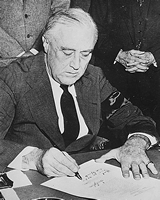 Photograph of President Franklin D. Roosevelt Signing the Declaration of War Against Japan, 12/08/1941, White House photographs taken by Abbie Rowe, 1941-1967, Courtesy of the National Archives (US), ARC ID 520053.
Photograph of President Franklin D. Roosevelt Signing the Declaration of War Against Japan, 12/08/1941, White House photographs taken by Abbie Rowe, 1941-1967, Courtesy of the National Archives (US), ARC ID 520053.
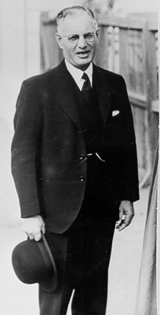 John Curtin aged 53, 1938. Records of the Curtin Family. JCPML00376/59.
John Curtin aged 53, 1938. Records of the Curtin Family. JCPML00376/59.
 The Task Ahead by John Curtin, the article in which Curtin famously proclaimed that 'Australia looks to America',
27 December 1941.
Click to view large size image of article.
Originally published in the Melbourne Herald.
Records of
The Task Ahead by John Curtin, the article in which Curtin famously proclaimed that 'Australia looks to America',
27 December 1941.
Click to view large size image of article.
Originally published in the Melbourne Herald.
Records of
John Curtin. JCPML00468/1.
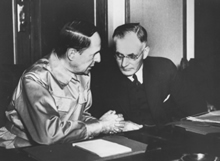 Prime Minister John Curtin and US General Douglas MacArthur, 194? JCPML00178/8.
Prime Minister John Curtin and US General Douglas MacArthur, 194? JCPML00178/8.
Courtesy of the National Archives of Australia: A1200 L36449.
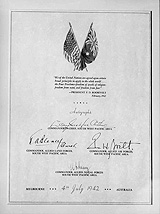 Photograph of a framed document with a statement by President F. D. Roosevelt about the objectives of the United Nations and autographs of armed forces commanders in Melbourne, Australia on the 4th July 1942. Argus Collection of War Photographs. Courtesy of the State Library of Victoria, accession no. H2000.200/1312, image no. an016614.
Photograph of a framed document with a statement by President F. D. Roosevelt about the objectives of the United Nations and autographs of armed forces commanders in Melbourne, Australia on the 4th July 1942. Argus Collection of War Photographs. Courtesy of the State Library of Victoria, accession no. H2000.200/1312, image no. an016614.
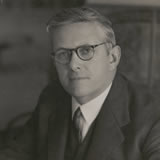 Portrait of Herbert Vere Evatt, Barton, Canberra, 1940. Courtesy of the National Library of Australia, bib ID vn4512486, call no. PIC/11999 LOC Box PIC/11999.
Portrait of Herbert Vere Evatt, Barton, Canberra, 1940. Courtesy of the National Library of Australia, bib ID vn4512486, call no. PIC/11999 LOC Box PIC/11999.
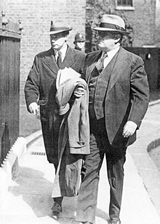 Curtin's Minister of External Affairs, Herbert Evatt, and Private Secretary to the Minister, John Burton, in London during the war, ca. 1944. Records of Bob Wurth. JCPML01224/120.
Curtin's Minister of External Affairs, Herbert Evatt, and Private Secretary to the Minister, John Burton, in London during the war, ca. 1944. Records of Bob Wurth. JCPML01224/120.
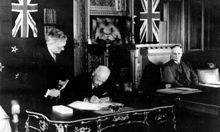 NZ PM Peter Fraser signing the ANZAAC Agreement watched by H.V. Evatt, John Curtin in the background. 21 January 1944. Records of Frederick McLaughlin. JCPML00018/21.
NZ PM Peter Fraser signing the ANZAAC Agreement watched by H.V. Evatt, John Curtin in the background. 21 January 1944. Records of Frederick McLaughlin. JCPML00018/21.
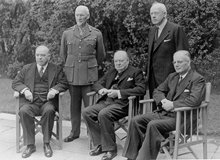 Curtin's visit to the US was scheduled prior to his attendance at the Empire Conference, London, UK May 1944. Left to right: Original Standing General Smuts (South Africa), Peter Fraser (N.Z.) Seated Mackenzie-King (Canada), Winston Churchill (U.K.), Curtin. Records of the Curtin Family. JCPML00376/77.
Curtin's visit to the US was scheduled prior to his attendance at the Empire Conference, London, UK May 1944. Left to right: Original Standing General Smuts (South Africa), Peter Fraser (N.Z.) Seated Mackenzie-King (Canada), Winston Churchill (U.K.), Curtin. Records of the Curtin Family. JCPML00376/77.
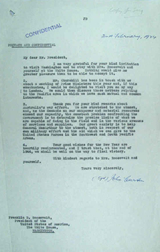 Letter from Prime Minister Curtin to President Roosevelt accepting his invitation to visit the U.S. on the way to the Prime Ministers Conference in the UK, 2nd February, 1944.
Letter from Prime Minister Curtin to President Roosevelt accepting his invitation to visit the U.S. on the way to the Prime Ministers Conference in the UK, 2nd February, 1944.
Courtesy of the National Archives of Australia, A5954, 646/4.